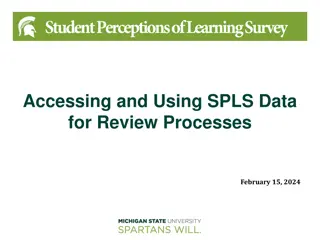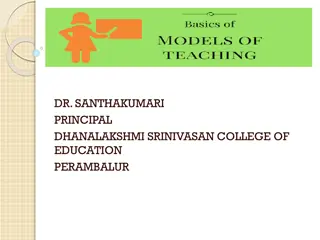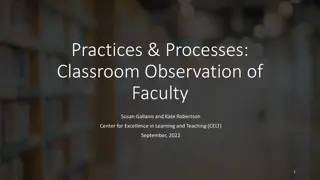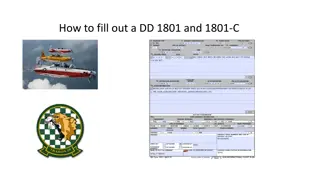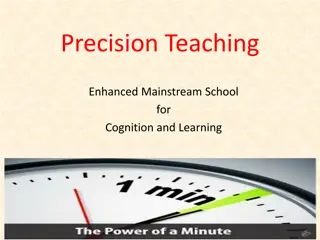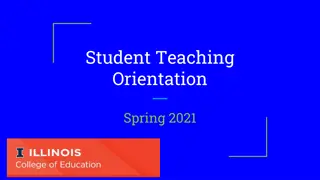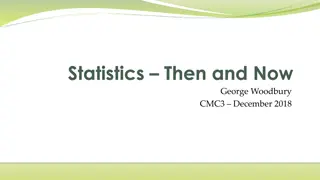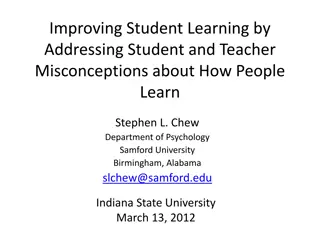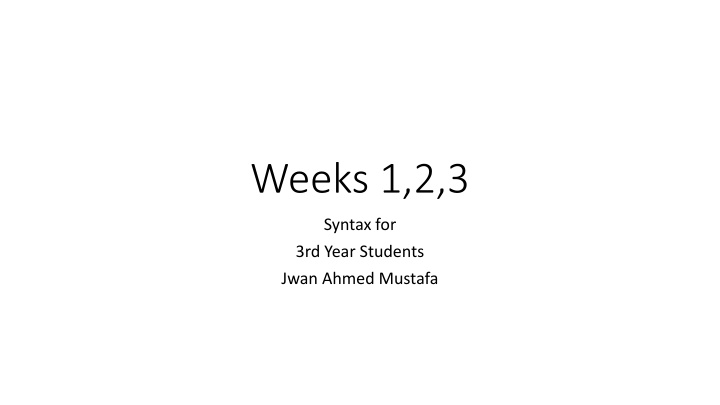
Syntax: Definition, Etymology, and Parts of Speech
Delve into the world of syntax with insights on its definition, origin, and components such as nouns, verbs, and adjectives. Explore the essential role of syntax in language structure and communication.
Download Presentation

Please find below an Image/Link to download the presentation.
The content on the website is provided AS IS for your information and personal use only. It may not be sold, licensed, or shared on other websites without obtaining consent from the author. If you encounter any issues during the download, it is possible that the publisher has removed the file from their server.
You are allowed to download the files provided on this website for personal or commercial use, subject to the condition that they are used lawfully. All files are the property of their respective owners.
The content on the website is provided AS IS for your information and personal use only. It may not be sold, licensed, or shared on other websites without obtaining consent from the author.
E N D
Presentation Transcript
Weeks 1,2,3 Syntax for 3rd Year Students Jwan Ahmed Mustafa
Etymology of syntax (Origin of SYNTAX) The word was first used in 1600, from French syntaxe (16c.) and directly from Late Latin syntaxis, from Greek syntaxis "a putting together or in order, arrangement, a grammatical construction," from stem of syntassein "put in order," from syn- "together" (see syn-) + tassein "arrange" (see tactics). http://www.etymonline.com/index.php. Date: 1500-1600
WHAT IS SYNTAX? Syntax, or syntactic analysis, may be defined as: (a) determining the relevant component parts of a sentence (b) describing these parts grammatically. The component parts of a sentence are called constituents. In other words, syntax involves the two closely related tasks of: (a) breaking down the sentence into its constituents (b) assigning some grammatical label to each constituent, stating what type of constituent (or grammatical category) it is, and what grammatical function it has. This definition of syntax implies that we start from what is regarded as the largest unit of syntactic description the sentence and proceed until we arrive at the smallest meaningful unit. This is called a top to bottom analysis. The units smaller than the sentence will be referred to as clauses, phrases, words and morphemes respectively.
Definition of syntax Syntax deals with the arrangement of words in sentences, clauses, and phrases, and the study of the formation of sentences and the relationship of their component parts. The main device for showing this relationship is word order in English, for example, The bird has made a nest. follows standard subject- verb-object SVO word order, and switching the order of such a sentence would change the meaning or make the sentence meaningless. Word order is much more flexible in languages such as Latin, in which word endings indicate the case of a noun or adjective; such inflections make it unnecessary to rely on word order to indicate a word's function in the sentence. (http://www.merriam-webster.com/dictionary/syntax)
Parts of Speech 1)Noun 2) Pronoun 3) Verb 4) Adjective 5) Adverb 6) Preposition 7) Conjunction 8) Interjection
WORDS AND WORD CLASSES Every speaker of English will intuitively recognise what the words in an English sentence are Faced with the string: (1) SoonafterbreakfastMaryAnnbroughtinTheTimes he will no doubt be able to identify the individual words in this sentence quite easily, and he will know that the appropriate word boundaries are as in (2) below, rather than as in (3): (1) Soon after breakfast Mary Ann brought in The Times. (2) *Soo naf terbre akfast Mary Ann broug htin TheT imes. If you know a language well enough, you can do this sort of demarcation of word boundaries quite automatically, by intuition. It is your linguistic competence which allows you to do this. Of course, such competence is maximal only for your mother tongue, and it is less than perfect for other languages which you do not speak fluently. And you have no such competence for the languages which you do not speak. If you do not know a language, you will find it impossible to identify the word boundaries in even the simplest sentences. The following string is an example of a very simple Welsh sentence followed by its translation in English: (1) Bethymayemrysyneiwneud? : What is Emrys doing? If you do not know Welsh, you will not be able to decide that the word boundaries are as follows: (1) Beth y may Emrys yn ei wneud? Words are grammatical units which a speaker of a language can intuitively recognise. After all, very little grammatical education is needed to be able to play Scrabble, and this game essentially relies on the recognition of words. The same applies to other word games.
The arrangement of a sentence pattern or a phrase will involve what kind of word class is used. When we write a declarative sentence for example, we begin with a subject and the subject is a noun. A word is classified into lexical words (open-class words) and grammatical words (closed- class words). Lexical category is related to a word class or a word function such as noun, verb, adjective, etc., and grammatical category refers to the words that shows grammatical relationship such as prepositions, pronouns, clause markers, articles, demonstratives, conjunctions..etc. Word classes are actually called parts of speech. There is no a fixed number of word classes known as parts of speech (Greenbaum and Nelson, 2002, p. 101). They divide English parts of speech into nine (noun, pronoun, adjective, adverb, verb, conjunction, preposition, determiner, and auxiliary verbs). Finegan (2004) does not include auxiliary verbs in parts of speech, so he argues that English parts of speech consist of eight. Meanwhile, Tamara (2007, p.5) includes modal verbs, articles, particles, and words of affirmation and negation as parts of speech. Table 1 below contains English parts of speech that are commonly used in most grammar books.
A. NOUN A noun can simply be defined as a word that denotes people, things, animals or places such as Bob (people), table (thing), crocodile (animal), and house (place). Altenberg and Vapo (2010) divide nouns for things into two different terms: animate and inanimate. An animate noun is a thing that is alive such as trees, cats, crocodiles, etc., and an inanimate noun refers to a thing that is not alive such as paper, stone, typewriter, etc. In traditional grammar there are seven types of nouns (proper, abstract, concrete, common, collective, mass, and compound). 1. Proper Noun: A proper noun is defined as a word or words that refer to a specific person, place, or thing (Lyn and Berk, 1999). In writing, a proper noun is usually capitalized. Examples of proper nouns are: Names of people, place, months, days, mountains, rivers, lakes, seas, oceans, journals, magazines, play, languages etc. 2. Common Noun: A common noun is a noun that refers to place, people, and thing such as river, woman, computer, and so on.
2. Abstract Noun An abstract noun can be defined as a thing which cannot be touched or seen as the concrete one such as patience, healthy, information, etc. 3. Concrete Noun A concrete noun is actually a class of common noun. This noun can be touched or seen such as chair, book, leaf, etc. 4. Collective Noun A collective noun is a noun that refers to a collection of individual entities such as family, team, faculty, audience, etc. Like a concrete noun, a collective noun is also one of the common noun classes. 5. Mass Noun A mass noun is actually the same term as uncountable noun. This noun is also a class of common nouns such as water, aqua, blood, gas, etc. 6. Compound Noun Another class of common noun is a compound noun. A compound noun is a noun consisting two or more words such as pickpocket, mailman,
PRONOUN PRONOUN A pronoun is defined as a word that is substituted for a noun for examples, as subjects, the words they for students, he for Ahmad, she for Linda, it for cat, etc. In a formal writing, a pronoun usually occurs after or is identified by its antecedent called a noun as in the following example. The students will submit their syntax assignment on Monday. The subject of the sentence above is students as antecedent, and their is a pronoun (possessive) referring to students. Types of pronouns: Greenbaum and Nelson (2002) divide a pronoun into eight types as in the following. a. Personal Pronoun :A personal pronoun consists of two cases as (subject and object) which distinguish first, second, and third person and singular and plural (number) as the following examples. They are working with their new job. Mr. Yad is a friendly math teacher in this school, so we like Him very much.
b. Reflexive Pronoun A reflexive pronoun is a pronoun that shows the doer and the recipient of the action of the verb. For example: Andrew usually cooks dinner himself. c. Possessive Pronoun: A possessive pronoun is a pronoun that indicates possession or ownership and is used to replace the noun that has already been mentioned previously such as the following example. The laptop on the table is hers. Hers is the same as her laptop. So, a possessive pronoun has a different pattern from possessive adjective in a sentence. A possessive adjective is always followed by a noun, while a possessive pronoun stands alone but as if there were a noun inside. d. Demonstrative pronoun: Demonstrative pronouns consist of four: this these, that those To identify these pronouns, we must look at their context in a sentence as they are also included in determiners. Let s consider the following examples. This doesn t belong to me. This book doesn t belong to me.
e. Indefinite pronoun: An indefinite pronoun is a pronoun that refers to the presence or absence of a quality such as both, some, several, few, etc, and includes a set of some and any such as somebody, anybody, something, anything, etc. f. Reciprocal: Greenbaum and Nelson (2002, p. 103) further state that there are two reciprocal pronouns such as: each other (each other s) one another (one another s) g. Relative Pronoun: A relative pronoun is actually an interrogative pronoun used in relative clauses such as who, whom, which, and whose, and includes that which is for who, whom, and which. These relative pronouns are always describing the preceded nouns. h. Interrogative Pronoun The interrogative pronouns include who, who, and whose. These pronouns appear when asking questions and they occur at the beginning of an interrogative sentence.
C. ADJECTIVES and ADVERBS AN ADJECTIVE is a word that describes a noun or a pronoun. An adjective may have different positions when modifying nouns. An adjective may or may not go together with nouns modified such as the following examples. The street is busy. The busy street is full of cars. The word busy in modifies street , but its position is separated from the word street . Similarly, the word busy in (9) also modifies street , but its position directly precedes the word street forming a phrase (noun phrase). Adjectives can be a common adjective found in a dictionary and a derived adjectives that come from verbs called verbal adjectives or participial. D. ADVERB: A word that describes a particular word class such as verb, adjective or adverb itself is called an adverb. Most adverbs in English are derived from adjectives ending with morpheme ly such as slowly, quietly, carefully, etc. Some adverbs are formed from nouns with suffix wise such clockwise or weather-wise. Few adverbs have the same form as adjectives for examples, hard, early and, fast or irregular ones such as well from an adjective good. Aarts (2001, p. 45) divides an adverb into three subclasses: circumstantial adverbs, degree adverbs, and sentence adverbs. A circumstantial adverb is an adverb that provides information about frequency (often called frequency of time) such as sometimes, never, often, etc. and about manner such as slowly, diligently, interestingly, etc. A degree adverb is an adverb that specifies the degree of its modifying adjectives such as extraordinary, pretty, very, etc. Meanwhile, a sentence adverb is an adverb that functions to link sentences such as probably, perhaps, however, etc.
E. VERB A verb is a word that denotes actions, sensations and states (Fromkin, 2001, p. 598). A verb is a word that is a constituent of sentence structure (Greebaum and Nelson, 2002, p. 21). Part of verbs: When we refer to the principal part of a verb, an English verb is classified into four parts (Azar, 2002) as in the following. 1. Simple present form: Simple present form is a root verb which usually occurs in dictionary as an entry. buy, play, come, drink eat, etc. 2. Simple Past Simple past form is a verb that ends with ed for regular and without ed for irregular. cook cooked (regular) work worked (regular) or write wrote (irregular). drink drank (irregular) 3. Past Participle: Past participle is also a verb that ends with ed for regular and without ed for irregular cook cooked - cooked (regular) work worked worked (regular) or write wrote - written (irregular). drink drank drunk (irregular) 4. Present Participle Present participle is a verb formed ending with ing for examples: playing, drinking, studying, etc.
Transitivity of Verbs a.A transitive verb is a verb that always requires an object in a sentence for example the verb buy in the sentence: Some examples of transitive verbs in English are: cut, give, lend, leave, make, offer, pass, sell, show, take, change, close, draw, drink, eat, move, open, paint, start, study, wash, write b. Intransitive Verb Unlike a transitive verb, an intransitive verb is a verb that does not need an object such as the following sentence. Keisha sleeps at nine every night. The verb sleep does not require an object. Some common intransitive verbs in English are: agree, appear, arrive, cry, go, laugh, smile, rain, run, sit, snow, talk, work, become, belong, cost, depend, die, disappear, dwell, emerge, exist, fall, go, happen, inquire, listen, laugh, live, look, occur, remain, respond, rise, sit, sleep, swim, vanish, wake, wait. c. Ditransitive Verb: A ditransitive verb is a verb that usually requires two objects such as in the following sentences: Ota gave me an umbrella. Eman will bring us some presents. When a sentence has two objects, there must be a direct object and an indirect object.
Some common ditransitive verbs are: allocate, allow, appoint, assign, award, bake, bet, bring, build, buy, catch, charge, cook, deliver, deny, design, do, draw, drop, earn, feed, fine, forgive, give, grant, guarantee, hand, leave, lend, make, name, offer, order, overpay, owe, pass, pay, permit, prescribe, promise, purchase, quote, read, sell, send, serve, set, show, take, teach, tell, throw, , write. Complex transitive: these are verbs: the are the verbs that take an object and a complement Example of this type: consider, elect, name, find,call Copula Copula is a verb followed by an adjective. The term linking verb is commonly used instead of copula. Thomas (1995, p. 46) would rather choose the terms intensive verb for copula. Woods (2001, p. 17) calls linking verbs being verbs as they express states of being. For learners of English syntax, whatever the name for copula should be adopted, one thing that they must know is to recognize verbs included in copula and to be able to use them into a good sentence structure. Here in this book we adopt the the term linking verbs for copula. The following are two examples of sentences with linking verbs. Linking Verbs: appear, feel, seem, sound, look, smell, turn, become, taste, prove, grow
Besides these classifications, there is another type of verbs called helping verbs which include modals and auxiliaries. Modals and auxiliaries are commonly used to go with verbs to form a verb phrase. The following Tables 4 and 5 are lists of common helping verbs in English. Can, could, may, might, must, shall, will, should, would (pure modals) Ought to, need (to), (have) to, help (to), dare (to) F. PREPOSITION A preposition is a word or a group of words used before a noun or pronoun to showplace, position, time or method (Hornby, 2002 p.1037). A preposition usually links with an adjective or a verb for examples: G. CONJUNCTION A conjunction is simply defined as a word that joins words, phrases or clauses. There are three kinds of conjunction: coordinating, subordinating, and correlative conjunction. A coordinating conjunction is the one that joins words, phrases or clauses such as and, or, but. A coordinating conjunction is used to make the words, phrases or clauses parallel. A correlative conjunction itself is similar to a coordinating conjunction, but this conjunction exists in pairs as listed in Table 8 below A subordinating conjunction is a conjunction that always joins two clauses such as because, since, if, etc.
H. DETERMINER A determiner is a part of a word class that usually modifies a noun. Nurgues (2006, p.5) does not include determiner in parts of speech and he uses the term participle for adjective. Greenbaun and Nelson (2002) add numerals as a different word class instead of determiner. Let s have few examples of sentences containing determiners. Q/Identify the word classes and their function. Give a check under each element it belongs to. Old English lasted about 400 years; this English would look and sound like a foreign language to English- speakers today. Although it's gone, Old English isn't forgotten. Remnants remain in Modern speech. You can thank (or blame) the Anglo-Saxons for most of their regular verbs, including the fact that you say ran instead of runned. In the Middle English period (1100 to about 1450) England was speckled with local dialects, each with its own vocabulary and sentence structure. Nobody studied grammar in school and nobody worried about what was correct or incorrect.
Subject and predicate The subject of a sentence tells who or what the sentence is about. The predicate of a sentence tells what the subject does or is. It includes the verb and its complements. Q/ Identify the subject and predicate of the following sentences: 1. Three big kids raced across the lawn. 2. The magician's trick amazed everyone. 3. Phil sent his friend a text message. 4. The creaky old door slammed shut. 5. My brother's best friend posted a message on Facebook. Q/ Rewrite the jumbled-up words into meaningful sentences. 1) climbed / out / two / spacemen / of the / rocket. 2) person / my / is a / grandfather/ very busy 3) God / to / we / daily / pray 4) by car / office / to / goes / Richard / his 5) the lion / known as / king / is / the jungle / of the
Sentence patterns: Pattern I: SVA (V: be) He was in London/(during the seventies). Pattern II: SVC (V: be/ linking verb, C: N) He was/ became a student (in London) (in 1977) Pattern III: SVC (V: be/Linking verb, C: Adj) He(gradually) was/became famous (in London) (in 1977). Pattern IV: SV (V: intransitive) He died (in London) (in 1985) Pattern V: SVO (V: monotransitive) Pattern VI: SVOi Od (V: ditransitive) He served his people many productive projects. Pattern VII: SVOC (V: complex transitive) They considerd him the symbol of hard working. Pattern VIII: SVOA (V: location) He put all his efforts in his projects. He served his college faithfully during his carrier.
In the sentences below, label each part of the sentence based on the terms used above: 1. The performance will be next month. 2. Your teacher is on this campus. 3. Michael s only hope was for a short respite. 4. Will you be my lab partner? 5. Shakespeare s writing was ingenious! 6. Joshua isn t being an obedient child. 7. Making a gourmet meal seems too time-consuming. 8. The mark looked distinct, like a fingerprint. 9. Don t become a cynic; they re no fun. 10. The audiences laughed.
11. The ground shook. 12. Maggie contacted her pharmacist. 13. That novel completes my collection. 14. David handed Terrance the ball when they were playing catch. 15. Give Cindy the notice once she leaves the meeting. 16. Do scientists really administer animals human medicines for lab testing? 17. The baker made the bread too chewy. 18. We elected him class president because of his speech. 19. The jury found the defendant not guilty of murder in the first degree. 20. Darcy considered Jane indifferent. 21. The train had arrived (quietly) (at the station) (before we noticed it) [9]


